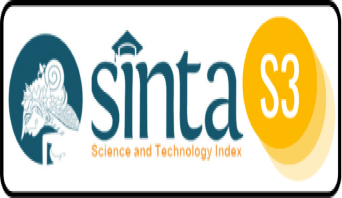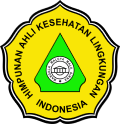FAKTOR RISIKO KERACUNAN PESTISIDA PADA PETANI HORTIKULTURA DI KABUPATEN LAMPUNG BARAT
DOI:
https://doi.org/10.26630/rj.v14i1.2138Keywords:
Pesticides, cholinesterase, horticulture, PPE, dosageAbstract
Pesticide poisoning is still an important health problem in agricultural areas, especially horticultural agriculture. Various chronic health effects can be caused by long-term exposure to pesticides. This study aims to determine the risk factor of pesticide poisoning in horticultural farmers in West Lampung Regency.
The study used a cross sectional design which was conducted in four different areas as the center of horticulture agriculture, West Lampung Regency, Lampung Province. The study involved 289 participants by interviewing, observing and examining blood samples to measure cholinesterase levels as an indicator of pesticide poisoning. In this section, we have applied research ethical procedures. The obtained data were analyzed using Chi squre test, Odds Ratio test and Logistic Regression.
The results showed that the risk factors for pesticide poisoning were incomplete use of personal protected equipment (PPE), spraying with the wrong dose and spraying frequency. Unwearing a complete PPE had a 4.54 times (OR = 4.54; 95% CI 2.09-9.83) higher risk of experiencing pesticide poisoning, and statistically suggested, a very significant relationship (p = 0.0001). While the use of excessive dosage has a risk of 4.39 times (OR = 4.39; 95% CI 1.87-10.33; p = 0.001); and the frequency of spraying more than twice a week had a 2.33 times higher risk of experiencing pesticide poisoning (OR = 2.33; 95% CI 1.24-4.40; p = 0.009).
Excessive use of pesticide dosage and the frequency of spraying with the cover blanked method are the main factors of pesticide exposure to farmers. On the other hand, the use of PPE is a method of protection from exposure. It needs joint efforts through increasing knowledge about the dangers of pesticides, pesticide management, how to work safely, and the use of PPE.References
Agustina, N., & Norfai, N. (2018). Paparan Pestisida terhadap Kejadian Anemia pada Petani Hortikultura. Majalah Kedokteran Bandung, 50(4), 215–221. https://doi.org/10.15395/mkb.v50n4.1398
Arwin, N. M., & Suyud, S. (2016). Pajanan pestisida dan kejadian anemia pada petani holtikultura di Kecamatan Cikajang , Kabupaten Garut tahun 2016. Berita Kedokteran Masyarakat, 32(7), 245–250.
Azmi, M. A., Naqvi, S. N. H., Azmi, M. A., & Aslam, M. (2006). Effect of pesticide residues on health and different enzyme levels in the blood of farm workers from Gadap (rural area) Karachi-Pakistan. Chemosphere, 64(10), 1739–1744. https://doi.org/10.1016/j.chemosphere.2006.01.016
BPS. (2019). Provinsi Lampung Dalam Angka 2019. Bandar lampung: BPS Provinsi Lampung.
Britt, J. K., & Budinky A, R. (2000). Principles of toxicology: Environmental and Industrial Applications, 2nd edition. In L. P. Williams, C. R. James, & M. S. Roberts (Eds.), John Wiley & Sons, Inc (2nd ed.). https://doi.org/10.1136/oem.58.8.545a
Del Prado-Lu, J. L. (2007). Pesticide exposure, risk factors and health problems among cutflower farmers: A cross sectional study. Journal of Occupational Medicine and Toxicology, 2(1), 1–8. https://doi.org/10.1186/1745-6673-2-9
Depnaker. Permenaker No 3 Tahun 1986 Tentang Syarat-Syarat Keselamatan dan Kesehatandi Tempat Kerja Yang Mengelola Pestisida. , Pub. L. No. No 3 Tahun 1986, 1 (1986).
Eskenazi, B., Harley, K., Bradman, A., Weltzien, E., Jewell, N. P., Barr, D. B., … Holland, N. T. (2004). Association of in utero organophosphate pesticide exposure and fetal growth and length of gestation in an agricultural population. Environmental Health Perspectives, 112(10), 1116–1124. https://doi.org/10.1289/ehp.6789
Fauziyyah, R., Suhartono, & Astorina, N. (2017). Studi Praktik Penggunaan Pestisida Dan Kejadian Anemia Pada Petani Buah Di Desa Tunggak Kecamatan Toroh Kabupaten Grobogan. Jurnal Kesehatan Masyarakat (e-Journal), 5(5), 860–870.
Istianah., & Yuniastuti, A. (2017). Hubungan Masa Kerja, Lama Menyemprot, Jenis Pestisida, Penggunaan APD dan Pengelolaan Pestisida dengan Kejadian Keracunan Pada Petani di Brebes. Public Health Perspective Journal, 2(2), 117–123.
Kapeleka, J. A., Sauli, E., Sadik, O., & Ndakidemi, P. A. (2019). Biomonitoring of Acetylcholinesterase (AChE) Activity among Smallholder Horticultural Farmers Occupationally Exposed to Mixtures of Pesticides in Tanzania. Journal of Environmental and Public Health, 2019, 1–11. https://doi.org/10.1155/2019/3084501
Kartini, A., Subagio, H. W., Hadisaputro, S., Kartasurya, M. I., Suhartono, S., & Budiyono, B. (2019). Pesticide exposure and stunting among children in agricultural areas. International Journal of Occupational and Environmental Medicine, 10(1), 17–29. https://doi.org/10.15171/IJOEM.2019.1428
Kemenaker RI. Peraturan Menteri Ketenaga Kerjaan Republik Indonesia No. 5 tahun 2018 tentang Keselamatan dan Kesehatan Kerja Lingkungan Kerja. , 4 Kemenaker RI § (2018).
Kementan, B. (2020). Teknik Penyemprotan Pestisida. Balitbang Pertanian, Kemnetan RI. Retrieved from hortikultura.litbang.pertanian.go.id
Kurniasih, S. A., Setiani, O., & Nugraheni, S. A. (2013). Faktor-faktor yang Terkait Paparan Pestisida dan Hubungannya dengan Kejadian Anemia pada Petani Hortikultura di Desa Gombong Kecamatan Belik Kabupaten Pemalang Jawa Tengah. Jurnal Kesehatan Lingkungan Indonesia, 12(2), 132–137. https://doi.org/10.14710/jkli.12.2.132
Nassar, A. M. K., Salim, Y. M., & Malhat, F. M. (2016). Assessment of pesticide residues in human blood and effects of occupational exposure on hematological and hormonal qualities. Pakistan Journal of Biological Sciences, 19(3), 95–105. https://doi.org/10.3923/pjbs.2016.95.105
Neghab, M., Jalilian, H., Taheri, S., Tatar, M., & Haji Zadeh, Z. (2018). Evaluation of hematological and biochemical parameters of pesticide retailers following occupational exposure to a mixture of pesticides. Life Sciences, 202(April), 182–187. https://doi.org/10.1016/j.lfs.2018.04.020
Novizan. (2008). Petunjuk Pemakaian Pestisida (1st ed.). Jakarta: AgroMedia Pustaka.
Okvitasari, R., Anwar, C., & Suparmin. (2016). Hubungan Antara Keracunan Pestisida Dengan Kejadian Anemia Pada Petani Kentang Di Gabungan Kelompok Tani Al Farruq Desa Patak Banteng Kecamatan Kejajar Kabupaten Wonosobo Tahun 2016. Politeknik Kesehatan Kemenkes Semarang, 299–310.
Patil, J. A., Patil, A. J., & Govindwar, S. P. (2003). Biochemical effects of various pesticides on sprayers of grape gardens. Indian Journal of Clinical Biochemistry, 18(2), 16–22. https://doi.org/10.1007/BF02867362
Prasetyaningsih, Y., Arisandi, D., & Retnosetiawati, P. D. (2017). Persentase Kejadian Anemia Pada Petani Terpapar Pestisida Di Kelompok Tani Karang Rejo, Dusun Krinjing Lor, Desa Jatisarono, Kecamatan Naggulan, Kabupaten Kulon Progo. THE 5TH URECOL PROCEEDING, (February), 452–457. Retrieved from http://lpp.uad.ac.id/wp-content/uploads/2017/05/59.-yuliana-prasetya-452-457.pdf
Rustia, H. N., Wispriyono, B., Susana, D., & Luthfiah, F. N. (2010). Lama Pajanan Organofosfat Terhadap Penurunan Petani Sayuran. Makara Kesehatan, 14(2), 95–101.
Sihana, F., Dawson, A. H., & Buckley, N. A. (2019). A bedside test for methemoglobinemia , Srilanka. Bulletin of the World Health Organization A, 1–5.
Yushananta, P., Ahyanti, M., & Anggraini, Y. (2020). Risk of pesticides on anaemia events in horticulture farmers. International Journal of Innovation, Creativity and Change, 13(2), 30–40
Downloads
Published
How to Cite
Issue
Section
License
Copyright (c) 2020 Ruwa Jurai: Jurnal Kesehatan Lingkungan

This work is licensed under a Creative Commons Attribution-NonCommercial 4.0 International License.

Ruwa Jurai: Jurnal Kesehatan Lingkungan is licensed under a Creative Commons Attribution-NonCommercial 4.0 International License.
Authors who publish with this journal agree to the following terms:
- Authors retain copyright and grant the journal right of first publication with the work simultaneously licensed under a Creative Commons Attribution-Non Commercial License that allows others to share the work with an acknowledgment of the work's authorship and initial publication in this journal.
- Authors are able to enter into separate, additional contractual arrangements for the non-exclusive distribution of the journal's published version of the work (e.g., post it to an institutional repository or publish it in a book), with an acknowledgment of its initial publication in this journal.
- Authors are permitted and encouraged to post their work online (e.g., in institutional repositories or on their website) prior to and during the submission process, as it can lead to productive exchanges, as well as earlier and greater citation of published work.

 Â Â Â
   







